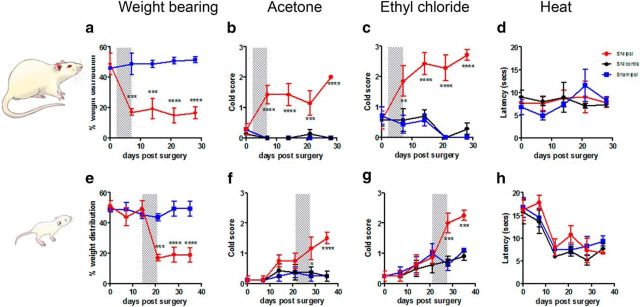Figure 2.
Infant nerve injury causes delayed-onset adolescent weight bearing and cold pain hypersensitivity. Top, Following SNI adult rats develop a rapid decrease in ipsilateral (a) weight bearing (SNI surgery: n = 4, sham surgery: n = 4, i.e., n = 4 per group), (b) increase in innocuous cool (acetone, n = 7 per group), and (c) noxious cold scores (ethyl chloride, n = 8 per group) 7 d after surgery, whereas (d) heat sensitivity is not affected (n = 3 per group). Bottom, Infant rats display a delayed response to SNI. Significant reductions in ipsilateral (e) weight bearing (n = 6 per group), and increases in (f) innocuous cool (n = 8 per group) and (g) noxious cold (n = 8 per group) scores develop 2–3 weeks after infant SNI. h, Thermal thresholds (n = 4 per group) are reduced over postnatal development but there are no differences between ipsilateral SNI and control paws. Shaded areas highlight the time period when hypersensitivity develops in each group. Graphs are presented as mean ± SEM (two-way ANOVA, adult rats: weight bearing: F(1,6) = 80.37, p = 0.0001, n = 4 per group; acetone F(2,18) = 46.83, p < 0.0001, n = 7 per group; ethyl chloride: F(2,18) = 75.29, p < 0.0001, n = 7 per group. Infant rats: weight bearing: F(1,10) = 28.13, p = 0.0003, n = 6 per group; acetone F(2,21) = 7.65, p = 0.0033, n = 8 per group; ethyl chloride F(2,21) = 8.719, p = 0.0018, n = 8 per group. Bonferroni's post hoc analysis; *p = 0.05, **p = 0.01, ***p < 0.001; ****p = 0.0001).

